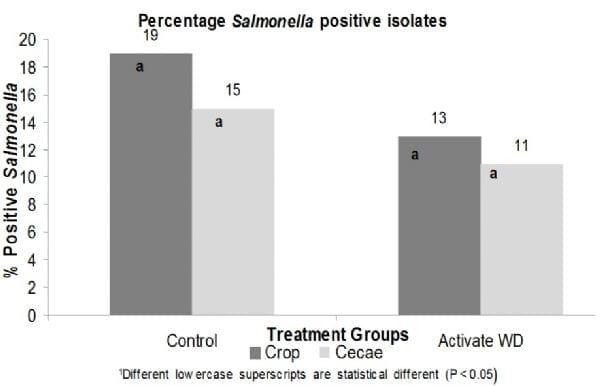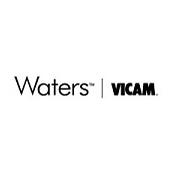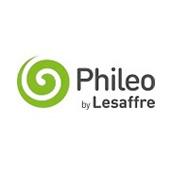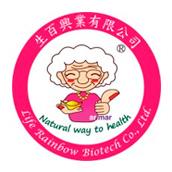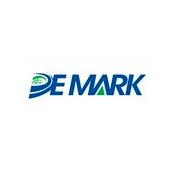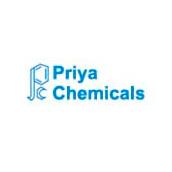Introduction
Salmonella have been recognized as leading bacterial causes of human gastroenteritis in the United States. In 2009, The Foodborne Diseases Active Surveillance Network (FoodNet) of Centers for Disease Control and Prevention (CDC) Emerging Infections Program (2010) that conducts active, population-based surveillance in 10 U.S. states reported 7,039 cases of Salmonella human foodborne illness. Epidemiological data suggest that contaminated products of animal origin, like undercooked ground beef, poultry carcasses and eggs, contribute significantly to these cases. With the perception that antibiotics should no longer be used as animal growth promoters, there has been widespread interest in natural methods of inhibiting detrimental bacteria. Among the natural methods the use of organic acids in the water or in the feed has been a practical and efficacious pre-harvest intervention in the reduction of Salmonella spp. incidence and colonization in broilers (Byrd et al., 2001; Cox et al., 1994; Dibner & Butti, 2002; Hinton & Linton, 1998). Acidification with various weak organic acids to diets such as formic, fumaric, propionic, lactic and sorbic acid have been reported to decrease colonization of pathogen and production of toxic metabolites, improve digestibility of protein and of Ca, P, Mg and Zn and serve as substrates in the intermediary metabolism (Kirchgessner & Roth, 1988). Organic acids have strong bacteriostatic effect and modulation effects in the microflora directly or indirectly (Dibner & Butti 2002; Richards et al., 2005). Activate® WD is a combination of liquid organic and inorganic acids including 2-hydroxy-4(methylthio) butanoic acid (HMTBa) a highly available source of methionine, that when combined with selected inorganic and organic acids, has been proven to produce a strong, antimicrobial synergistic effect in the water. The objective of this field trial was to evaluate the performance of organic acid Activate® WD water treatment during the first seven days and the last seven days of the grow-out phase as a preharvest intervention on the reduction of Salmonella spp. in broiler chickens.
Materials & Methods
A 16 house research farm was selected for two consecutive trials. A total of 352,000 broiler chickens for the first trial and 352,000 broiler chickens for the second trial were divided in two treatment groups. Eight houses were selected as control groups where birds received normal water and the other eight houses were selected as the treatment groups where birds received the water treatment. Before placement all houses received a water line treatment with citric acid for 24 hours. Activate® WD was administered to the treatment houses twice during the grow out. First, at placement through 7 days of age and then during the last full week of the grow out. The water treatment program was monitored daily during treatment to ensure a pH of approximately of 4 was reached the first week of grow out and a pH of 3.5 was reached the final week. Seven days prior to processing and just prior to water treatment started all houses were environmentally sampled for Salmonella. Four boot sock samples were collected per house (4 samples X 16 houses = 64 samples per sample day). Just prior to catching (after feed withdrawal), the following samples were taken from each house: 30 carcass rinses feather on, 10 crops, and 10 ceca. A total of 50 samples per house were collected for Salmonella testing for the first trial. In the second trial before the water treatment during the last full week of the grow out the following samples were collected (10 crops and 10 ceca per house) and just prior to catching (after feed withdrawal) the following samples were taken from each house: 10 crops, and 10 ceca. Samples were sent to the Poultry Diagnostic and Research Center at University of Georgia for Salmonella testing.
Results & Discussion
Results showed 88% positive Salmonella isolates in the boot sock samples obtained prior to treatment for the Activate® WD treatment groups compared to 66% positive Salmonella isolates on the boot socks samples on the Control treatment groups. A reduction of Salmonella isolates in the crop (Control 19% vs. Activate® WD 13%), and ceca (Control 15% vs. Activate® WD 11%) was observed in Fig. 1. Results also showed a reduction of Salmonella on carcass rinses (feathers on: Control 4.32 log10 MPN organisms/ml average culture-positive samples vs. Activate® WD 3.66 log10 MPN organisms/ml average culture-positive samples) for the Activate® WD treatment groups compared with the control groups. No statistical differences were found among the treatment groups in the first trial. In the second trial, results showed a reduction of Salmonella isolates in the crop (Control 39% vs. Activate® WD 18%), and ceca (Control 31% vs. Activate® WD 21%) prior to the starter of water treatment during the last full week of the grow out. A reduction of Salmonella isolates in the crop (Control 20% vs. Activate® WD 9%), and ceca (Control 24% vs. Activate® WD 3%) post water treatment during the last week of the grow out also was observed. Statistical differences were found among the treatment groups in the second trial. Parker et al. (2007) reported that Activate® WD interrupted successfully the cycle infection of Salmonella in uninfected chickens which significantly lower Salmonella levels in the litter resulted in lower levels in the crops and ceca of uninfected birds.
Fig.1. Percentage of Salmonella positive isolates for the ceca and crop in the treatment groups
Conclusion
In conclusion, Activate® WD reduced the present of Salmonella spp. in the carcasses, crop and cecas when administrated in the water during the first seven days and during the last seven days of the life of the birds as a pre-harvest intervention.
® Activate WD is a trademark of Novus International, Inc., and is registered in the United States and other countries.
Biography
Byrd JA, Hargis BM, Caldwell DJ, Bailey RH, Herron KL, McReynolds JL, Brewer RL, Anderson RC, Bischoff K M, Callaway TR, Kubena LF. 2001. Effect of lactic acid administration in the drinking water during preslaughter feed withdrawal on Salmonella and Campylobacter contamination of broilers. Poultry Sciences 80:278-283.
Centers for Disease Control and Prevention Morbidity and Mortality Weekly report. 2010.Preliminary FoodNet Data on the Incidence of Infection with Pathogens Transmitted Commonly Through Food - 10 States, 2009 http://www.cdc.gov/mmwr/pdf/wk/mm5914.pdf. Acceso: 16- April-2010.
Cox NA, Mchan F, Bailey JS. 1994. Effect of butyric or lactic acid on the in vivo colonization of Salmonella typhimurium. J. Applied Poultry Research 3:314-318.
Dibner JJ & Buttin P. 2002. Use of Organic Acid as a Model to Study the Impact of Gut Microflora on Nutrition and Metabolism. Poultry Science 11:453-463.
Hinton M & Linton AH. 1998. Control of Salmonella infections in broilers chicken by the acid treatment of their feed. Veterinary Record 123:416-415.
Kirchgessner VM & Roth FX. 1988. Ergotrope effekte durch organische sauren in der ferkelaufzucht und schweinemast. Ubers. Tierernaehr. 16:93-108.
Parker D, Hofacre C, Mathis G, MA Quiroz, Knight C, Dibner JJ. 2007. Organic acid water treatment effective decreasing Salmonella colonization and horizontal transmission in broiler chickens. Proceedings of the 16th European Symposium on Poultry Nutrition. Strasbourg, France.
Richards JD, Gong J, Lange CF. 2005. The gastrointestinal microbiota and its role in monogastric nutrition and health with an emphasis on pigs: Current understanding, possible modulations and new technologies for ecological studies. Can. J. Anim. Sci. 85:421-435.
